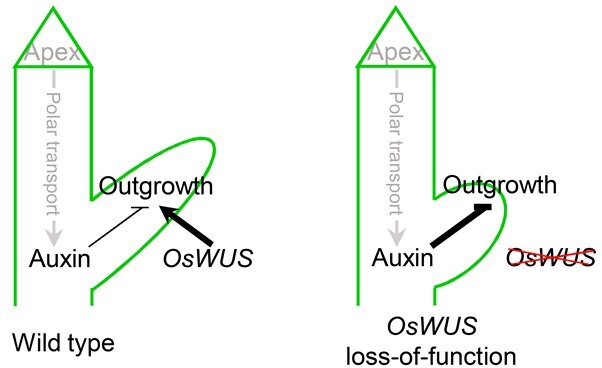Cereal crops exhibit two distinct types of branching which are the important determinants of crop yield. Crops such as maize and sorghum produce only one culm to reduce competition among sinks and increase the productivity of the main culm, thus exhibiting enhanced apical dominance. Rice and wheat produce multiple tillers (a type of branch that is similar in shape and height to the main culm) and exhibit weakened apical dominance.
It has long been known that auxin is an important signal for apical dominance. Auxin synthesized in the shoot apex moves downward to inhibit bud outgrowths without entering into them. However, the genetic basis of weak apical dominance in rice remains largely unknown.
Recently, a research team led by Prof. Chen Fan from the Institute of Genetics and Developmental Biology of the Chinese Academy of Sciences has isolated and characterized a decreased culm number 1 (dc1) mutant in rice, which exhibits malformed spikelet, female sterile and extreme low-tillering.
The researchers conducted map-based cloning. The result showed that a 4-bp deletion (“GCGG”) in the coding sequence of OsWUS was observed in the dc1 mutant, which resulted in a protein frame shift and a premature stop codon. OsWUS, ortholog of Arabidopsis WUSCHEL in rice, encodes a WUSCHEL-related homeobox transcription factor and plays a crucial role in rice tiller bud development.
Furthermore, they found that auxin response and apical dominance were enhanced in the dc1 mutant. Decapitation or disruption of the auxin-associated gene ASP1 partially de-repressed the growth of tiller buds in the dc1 mutant, indicating that OsWUS positively regulates the tiller bud growth via antagonizing the auxin action.
This study uncovers a novel mechanism of weak apical dominance in rice, as well as an important role of OsWUS in tiller bud growth. This study provides the basis for an improved understanding of tiller bud development in rice.

Read the paper: The Plant Journal
Article source: Chinese Academy of Science
Author: ZHANG Nannan
Image credit: CCO








